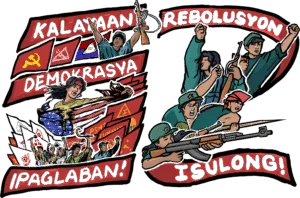On February 25, 1986, two million people swarmed the streets and converged at Epifanio de los Santos Avenue (EDSA) at the heart of Metro Manila, in defiance of fraudulent elections and in protest against the Marcos fascist dictatorship. The EDSA People Power Uprising succeeded in toppling Marcos Sr., but it failed to dismantle the foundations of elite rule and foreign domination. It changed the face of power – but not its class character. The EDSA uprising is an unfinished revolution, and its lessons remain important to bring it to its revolutionary conclusion.
Since then, successive regimes have consistently sought to erase or dilute the revolutionary memory of the Filipino people by manipulating how history is taught and remembered. Over the years, textbook revisions have downplayed the crimes of the Marcos fascist regime, and softened the language around martial law. The current Marcos Jr. regime has even removed the EDSA commemoration from its list of non-working holidays. This is part of a broader campaign of historical distortion and a systematic attempt to erase the memory of EDSA from national consciousness. By erasing the memory of EDSA, the reactionary state aims to rob a new generation of Filipinos of the lessons of resistance, people’s unity, and the unfinished struggle for genuine democracy.
But Marcos Jr.’s brazen action to undermine the essence of the EDSA uprising has not gone unchallenged. On February 25, 2025, thousands of Filipinos marched once again to the People Power Monument to commemorate EDSA’s 39th anniversary to express widespread objection to Marcos Jr.’s attempt to erase the crimes of his father’s fascist dictatorship.
More than 400 schools nationwide cancelled classes as an act of defiance against Marcos Jr.’s decision to downgrade the event as a mere special working holiday. Some schools even encouraged their faculty and students to join the protest. Students from various universities who refused to suspend classes staged walkouts and protests.
The protesters stress the importance of keeping the EDSA uprising’s essence alive as Filipinos still face worsening poverty, rising inflation, widespread corruption, foreign corporations exploiting the country’s natural resources, and continued US military intervention. They added that the EDSA uprising is an unfinished revolution. And with another tyrannical Marcos back in power, EDSA’s spirit is more relevant than ever.
The situation today bears the same conditions that ignited the EDSA uprising nearly four decades ago: a ruling family once ousted for corruption and tyranny is back in power, emboldened by a machinery of disinformation and state repression. The same crises persist – landlessness, joblessness, foreign plunder of resources, mounting debt, and brutal attacks on activists, workers, and rural communities. These objective conditions demand not just another regime change. As NDFP Secretary-General Elias Dipasupil stressed, the true victory of the EDSA People Power Uprising can only be achieved by bringing it to its full revolutionary conclusion. This means winning the people’s war and establishing a genuine people’s democratic government – one that dismantles elite rule and champions the needs of the majority. It means implementing genuine land reform, building national industries, asserting sovereignty, and advancing the NDFP’s 12-point program as a roadmap for fundamental change. Only by pursuing this path can the Filipino people move toward a truly just, free, and socialist future.

